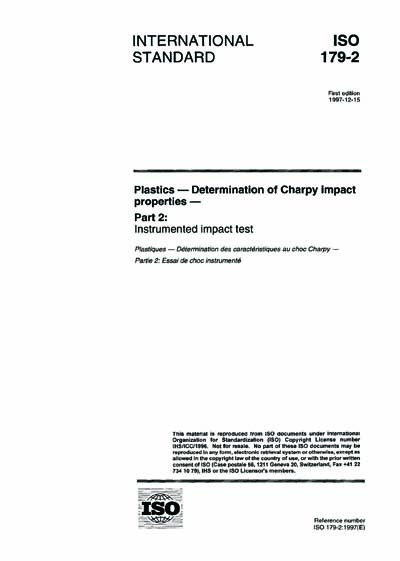Historical
ISO 179-2:1997
Plastics - Determination of Charpy impact properties - Part 2: Instrumented impact test
This part of ISO 179 specifies a method for determining Charpy impact properties of plastics from force-deflection diagrams. Different types of rod-shaped test specimen and test configuration, as well as test parameters depending on the type of material, the type of test specimen and the type of notch are defined in part 1 of ISO 179.
Dynamic effects such as load-cell/striker resonance, test specimen resonance and initial-contact/inertia peaks are described (see figure 1, curve b, and annex A).
For the comparison between Charpy and lzod test methods, see ISO 179-1, clause 1.
ISO 179-1 is suitable for characterizing the impact behaviour by the impact strength only and for using apparatus whose potential energy is matched approximately to the particular energy to break to be measured (see ISO 13802, annex C). This part of ISO 179 is used if a force-deflection or force-time diagram is necessary for detailed characterization of the impact behaviour, and for developing automatic apparatus, i.e. avoiding the need, mentioned above, to match energy.
For the range of materials which may be tested by this method, see ISO 179-1, clause 1.
For the general comparability of test results, see ISO 179-1, clause 1.
The method may not be used as a source of data for design calculations on components. However, the possible use of data is not the subject of this part of ISO 179. Any application of data obtained using this part of ISO 179 should be specified by a referring standard or agreed upon by the interested parties.
Information on the typical behaviour of materials can be obtained by testing at different temperatures, by varying the notch radius and/or specimen thickness and by testing specimens prepared under different conditions.
It is not the purpose of this part of ISO 179 to give an interpretation of the mechanism occurring at every point on the force-deflection diagram. These interpretations are a task for on-going scientific research.
The test results are comparable only if the conditions of test specimen preparation, as well as the test conditions, are the same. Comprehensive evaluation of the reaction to impact stress requires that determinations be made as a function of deformation rate and temperature for different material variables such as crystallinity and moisture content. The impact behaviour of finished products cannot, therefore, be predicted directly from this test, but test specimens may be taken from finished products for testing by this method.
Impact strengths determined by this method may replace those determined using ISO 179-I if comparability has been established by previous tests.
International Organization for Standardization [iso]


